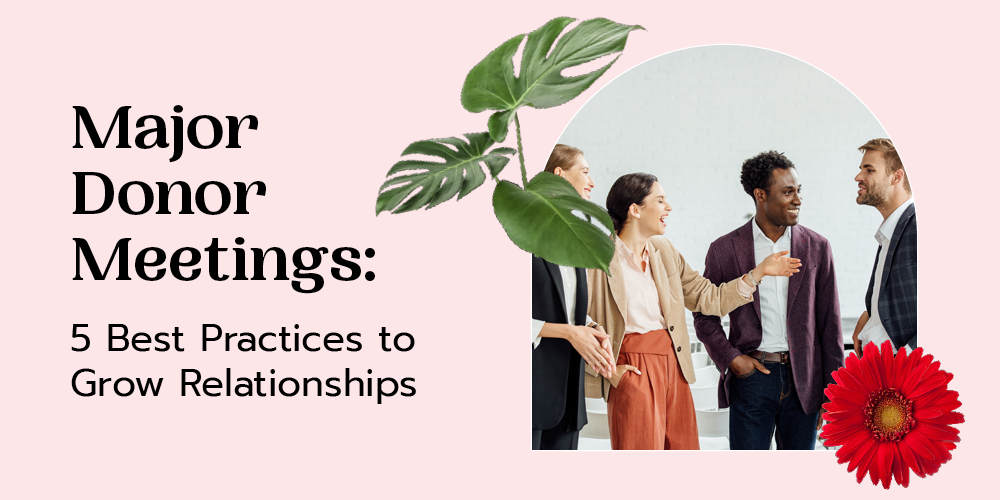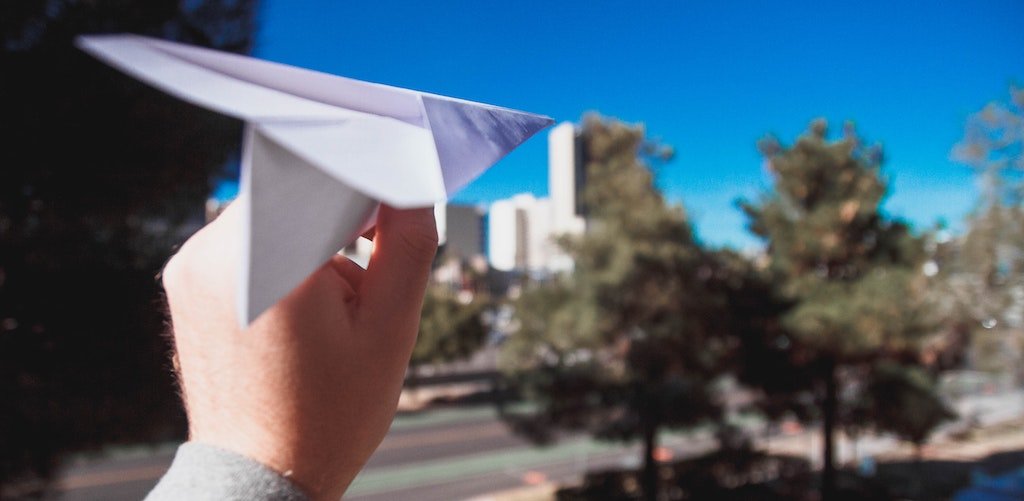
For most nonprofits, a large percentage of total funding comes from a small group of donors who make large or major donations to your organization. These donors are known as major donors. Major donor qualifications vary depending on the size and fundraising goals of each nonprofit. But no matter how you decide who qualifies as a major donor, you know that they’re a critical component of your organization’s overall success.
That’s why it’s essential to host engaging and inspirational one-on-one meetings with prospective major donors. Donor meetings give you the chance to get to know donors on a deeper level, understand their passions and motivations, and propose giving opportunities that appeal to their interests.
A productive major donor meeting requires careful planning. We recommend following these five best practices for hosting better donor meetings:
- Establish a goal for the meeting.
- Research donors thoroughly ahead of time.
- Ask donors questions about themselves.
- Give donors a great experience.
- Follow up after the meeting.
Kickstarting your major gift fundraising efforts with a strategic approach to major donor meetings can give you a solid foundation to grow and deepen these crucial relationships. Let’s take a closer look at what it takes to plan engaging donor meetings.
1. Establish a goal for the meeting

Every major donor meeting you host should have a goal. Setting goals for these meetings helps keep them focused and gives you a way to measure the success of the meeting. At the very least, each meeting should aim to build a strong connection with the prospective donor.
If you’re holding an introductory meeting, your goal shouldn’t be financial. Donors are more likely to donate to your organization or cause if they feel a connection to it. Instead of making a major ask, you can set a goal of learning more about the individual and what they’re passionate about. Plan to leave with a deeper understanding of the prospect’s philanthropic goals and a follow-up meeting on the calendar.
If you’re meeting a prospect you’ve been communicating with for a while, your meeting may be focused on a specific fundraising request. In that case, you may want to ask for a donation during the meeting.
It’s always good to have a backup plan in place in case a prospect isn’t ready to commit to a donation that day. Consider ways to keep the door open by asking follow-up questions about whether the prospect needs more information, a different gift amount, or time to think about your request.
Setting goals for your donor meetings gives you an objective to strive for and makes the meetings more purposeful for both you and the prospect.
2. Research donors thoroughly ahead of time.

Enter every major donor meeting with a basic understanding of the prospective donor’s background and the types of organizations they’ve supported in the past. This can help you strike up a natural conversation and highlight aspects of your mission that will resonate strongly with each prospect.
You can use your donor management software to research prospects ahead of time. Some donor management systems are equipped with prospect research tools, like the Bloomerang and DonorSearch integration. Working together, these solutions allow you to gather prospective donor information such as:
- Any existing connections between your prospects and current donors, board members, staff members, volunteers, or other individuals involved with your organization
- Their philanthropic history, including philanthropic giving and other involvement with nonprofits (such as serving on a board or volunteering)
- Their capacity to give based on wealth markers such as real estate holdings and stock ownership
The more you know about prospective donors ahead of time, the better. This information will help you prepare a strong case for support. You can personalize each major donor meeting based on this data.
For example, let’s say you have a prospective donor who recently moved to your city. You discover this individual previously served on the board of a similar nonprofit organization. In your meeting with them, you can ask them about this experience and inquire about whether they’d be interested in joining your organization’s board in the future.
Another prospect might have volunteered with your organization in the past. Using a wealth screening tool, you determine this individual has a high giving capacity based on several wealth indicators. When you make your ask, you can highlight how their gift can directly benefit future volunteers by equipping them with the supplies needed to serve the community.
Doing thorough research will also allow you to understand the types of stories that prospective donors will appreciate hearing about your organization. Prospective supporters will appreciate knowing that their gifts will go directly toward causes that are near and dear to their hearts.
3. Ask donors questions about themselves
Consider the experience you think the prospect would like to have during the meeting. They likely want to feel that you value their time and support and care about them for reasons other than their ability to make a donation. Show your prospective major donors that you’re interested in them by using that time to ask them questions about themselves.
You can ask questions like:
- What philanthropic causes are you most passionate about?
- What draws you to our organization?
- What kind of impact are you looking to make with your charitable giving?
- What kinds of giving are most fulfilling to you? (monetary donations, in-kind gifts, gifts of stock, etc.)
These questions can help you understand your major donors’ perspectives and the type of programs or projects they may be interested in supporting.
4. Give donors a great experience

Anything you can do to wow your prospective donor and create a positive first impression will help grow their affinity for your organization. That’s why you should put time and energy into creating an engaging and fulfilling visit for your prospective donors.
Your organization might host in-person visits with prospective major donors. In that case, you have a valuable opportunity to steward prospective donors in person by inviting them to visit your nonprofit and see your organization in action. To create a memorable first impression, you should:
- Greet them at the door when they arrive.
- Introduce them to any staff members or volunteers who are on site.
- Give them a tour of your facilities.
- Offer snacks and refreshments or a full luncheon.
You don’t want your major donor meetings to feel stuffy, formal, or boring. Do what you can to create a welcoming environment.
5. Follow up after the meeting

Whether prospective major donors give or not, create a plan to stay in touch with them after your meeting.
If an individual decides not to give, thank them for their time and ask if they’d like to receive any future communications from your organization. If they do, you can create a stewardship plan that will help you maintain a positive relationship with this prospect. If they’re not interested in supporting your organization financially or otherwise, you should also respect that decision. However, you should still thank them for their time via email or handwritten note.
For those who decide to give or indicate they may be willing to give in the future, Bloomerang recommends the following ongoing donor stewardship activities:
- Staying in touch using digital platforms like your social media pages and email newsletters
- Inviting donors to participate in activities that don’t involve donating, like volunteering or attending a nonprofit event
- Calling your donors occasionally to check in and thank them for their gift or ask for their feedback
- Inviting donors to join your major donor society and access exclusive perks, such as special VIP event invitations
Finally, make sure prospective and current major donors know who to get in touch with on your nonprofit’s team if they have questions or concerns.
Major donor meetings are your nonprofit’s opportunity to get to know prospective supporters on a more personal level. Keep the focus of these meetings on understanding your prospects’ perspectives and what they’re hoping to gain from supporting your organization. Doing so will show prospects that you’re dedicated to creating a positive, fulfilling experience for them as a major donor.
_________________________
Guest post by Ann Fellman, Bloomerang
As the Chief Marketing Officer at Bloomerang, Ann is responsible for the company's overall thought leadership, brand, marketing, and community outreach programs that work to strengthen relationships with customers and the broader nonprofit community. Ann brings with her more than 24 years of experience in business-to-business (B2B) marketing in the technology industry, including time spent working at a nonprofit organization.
